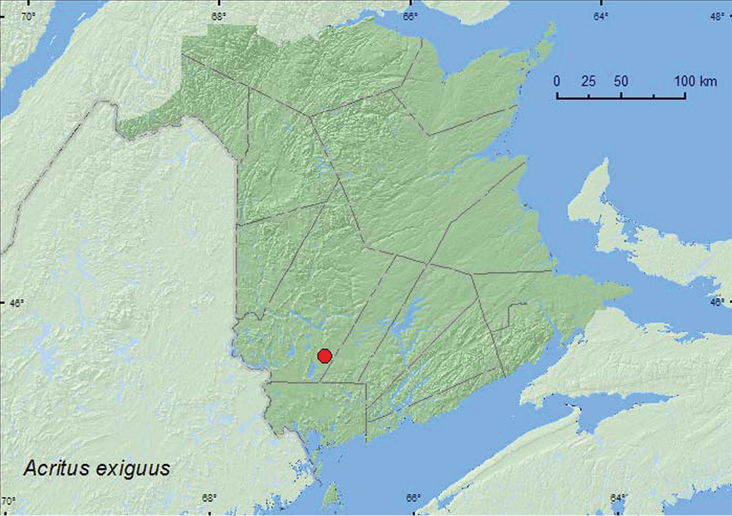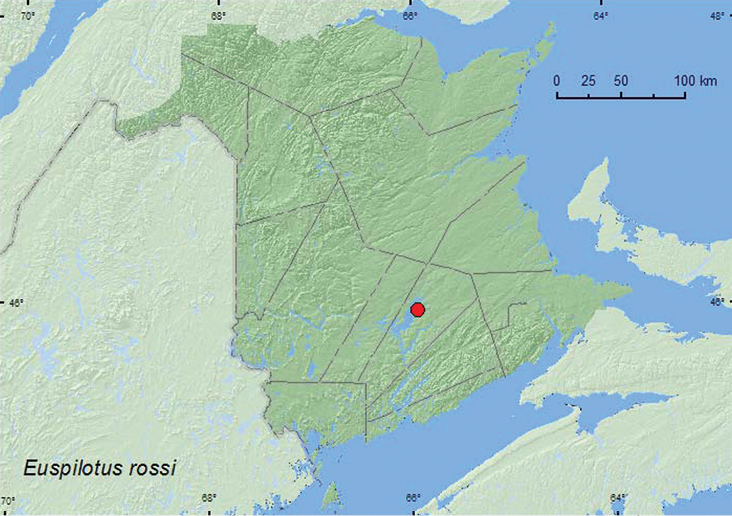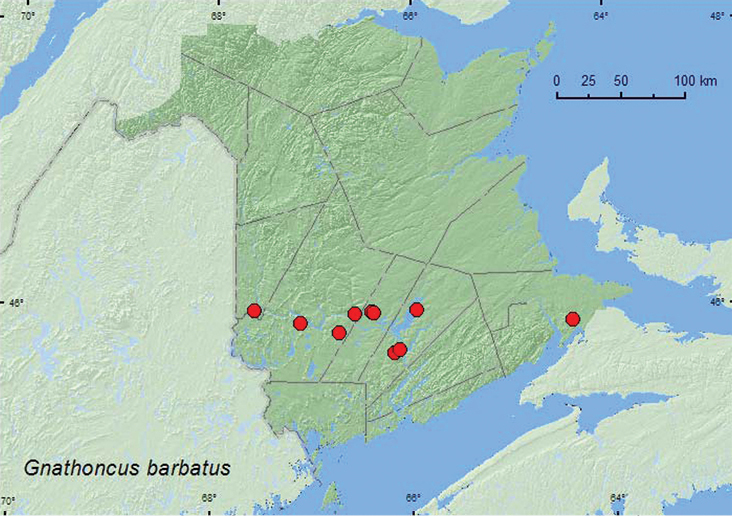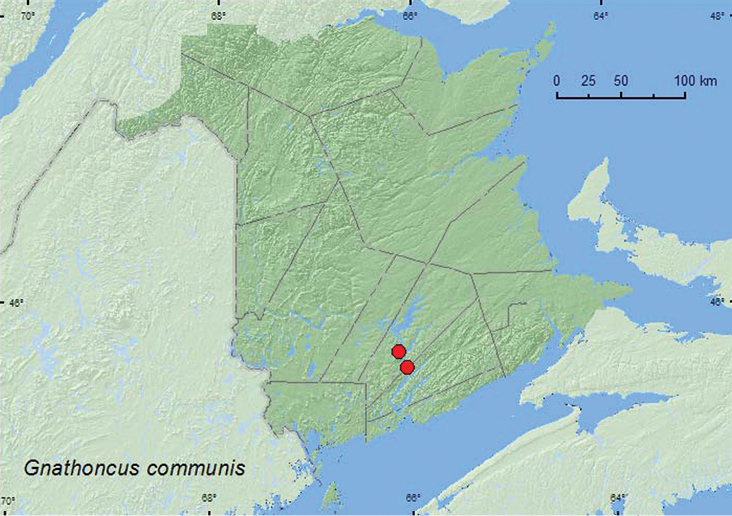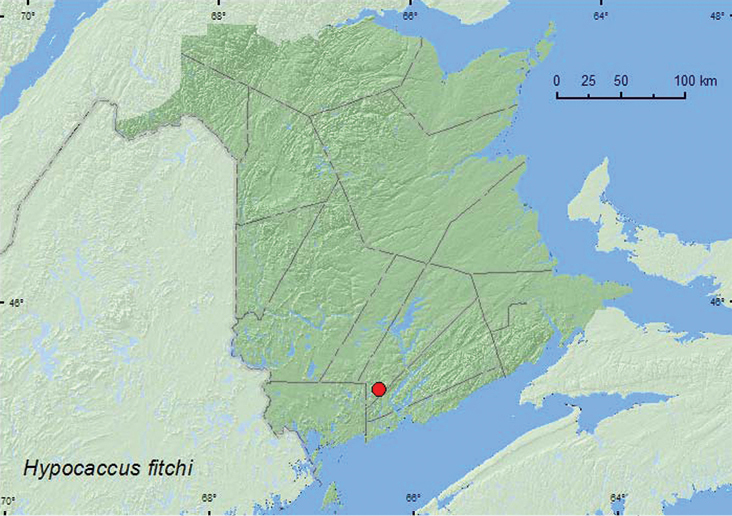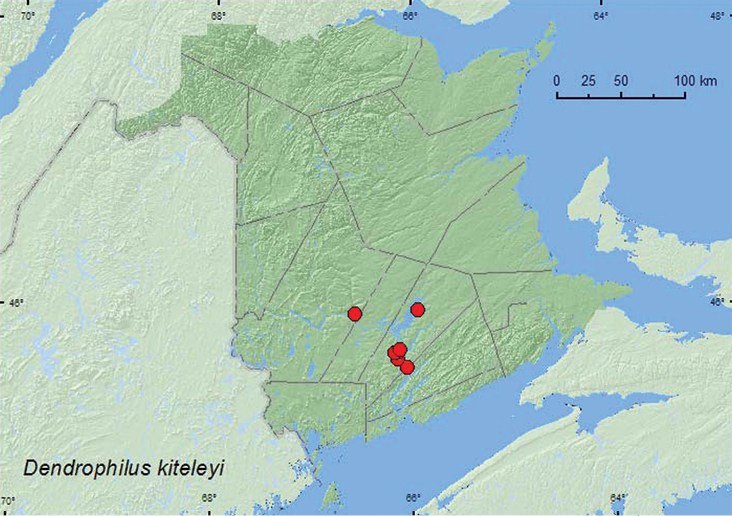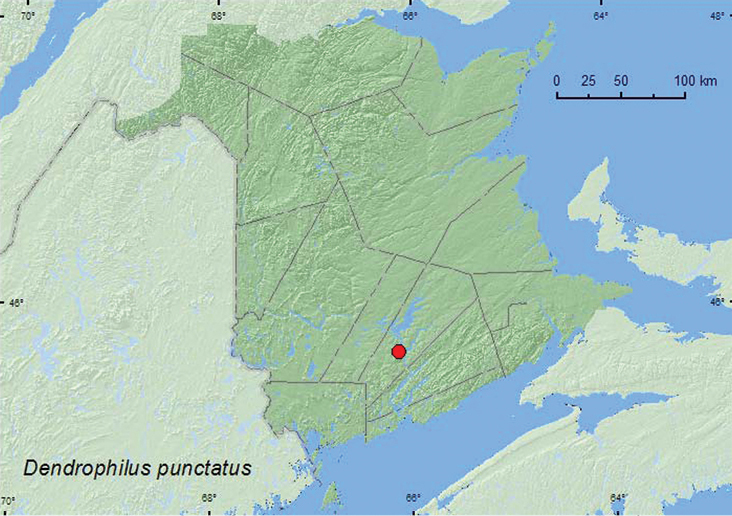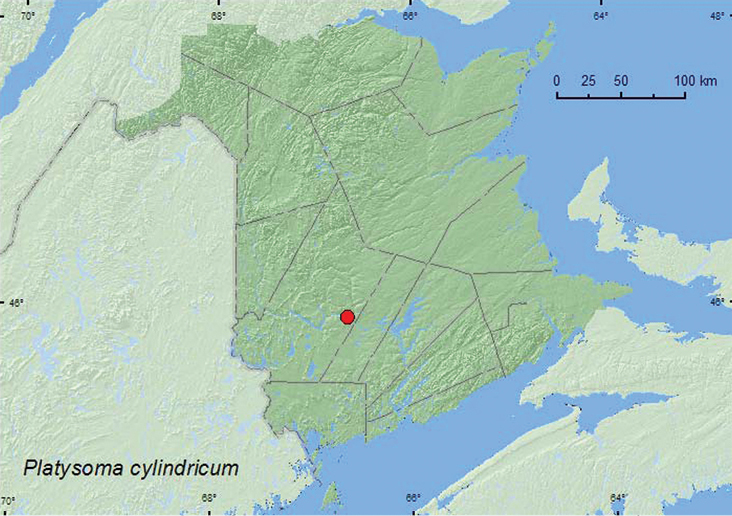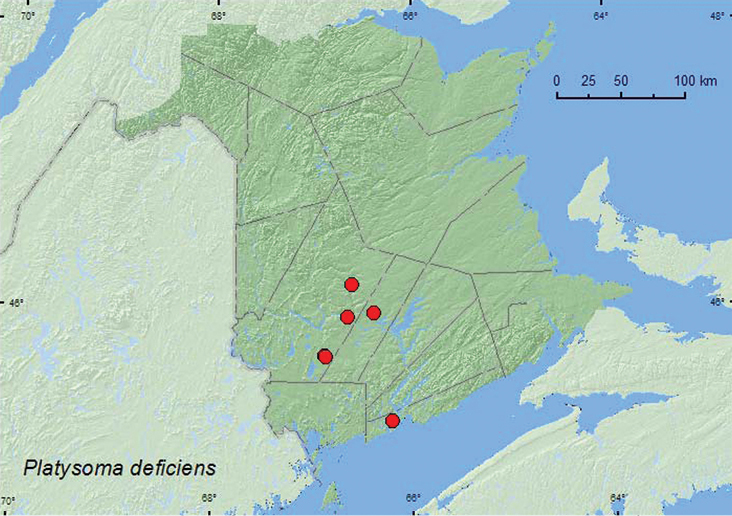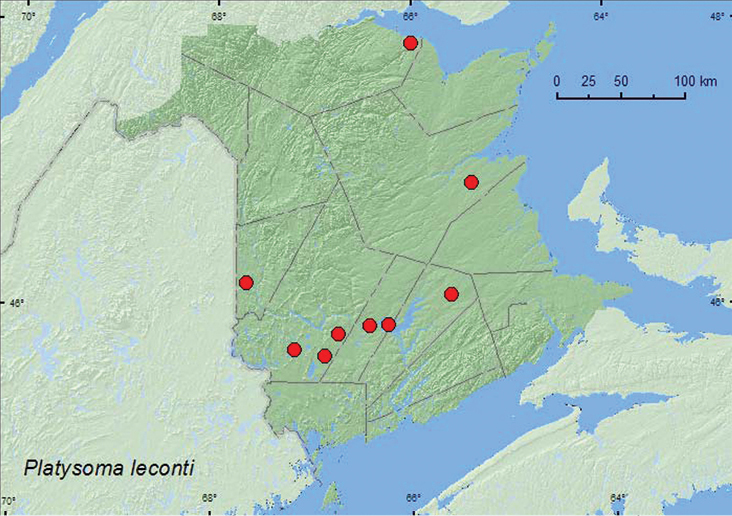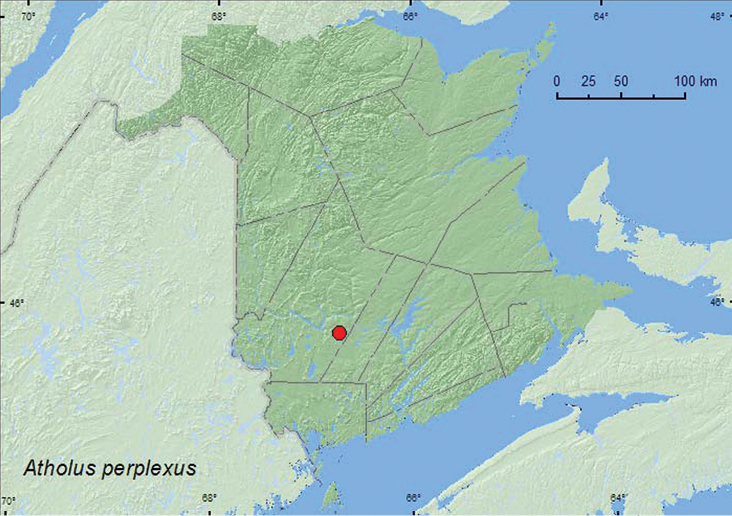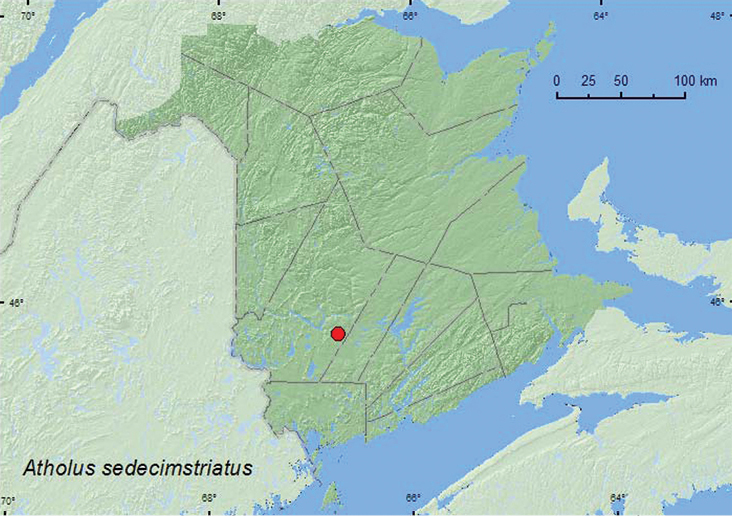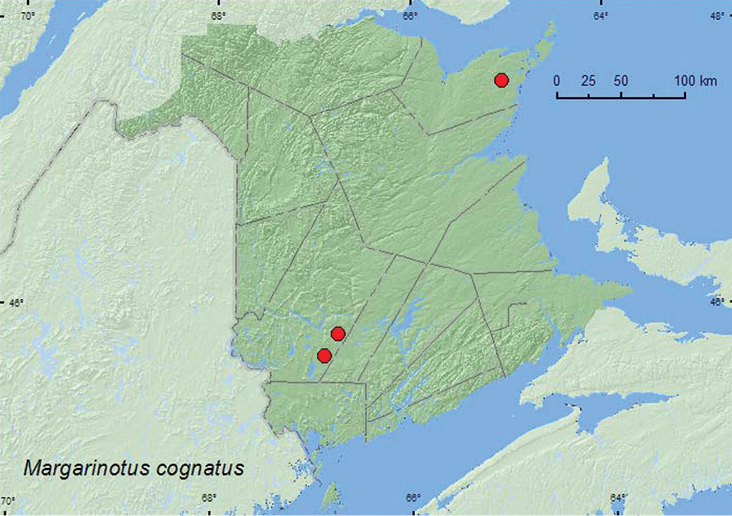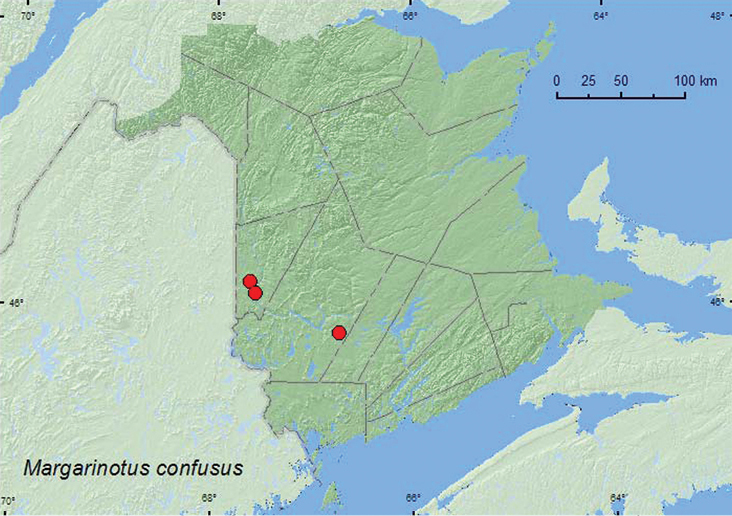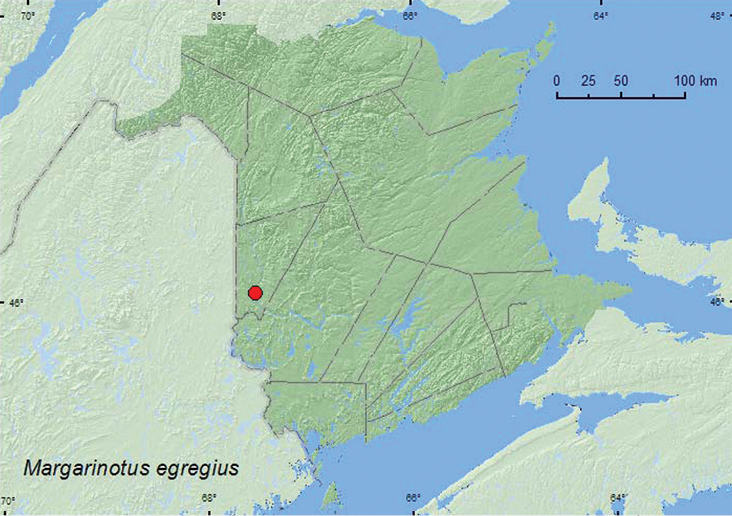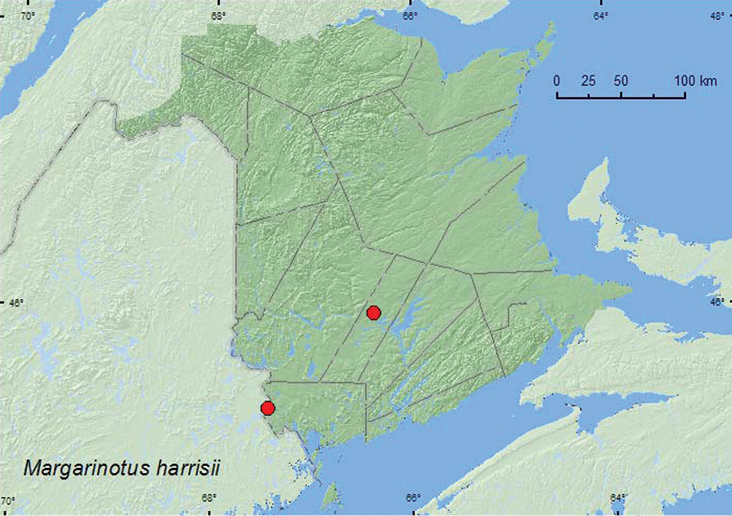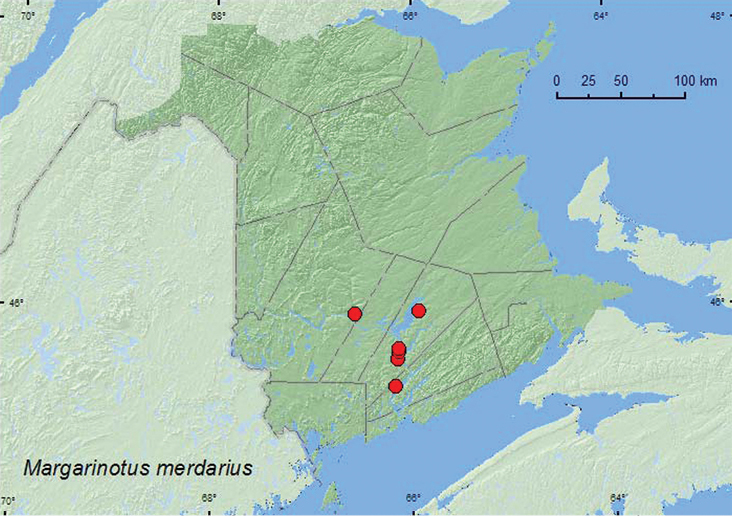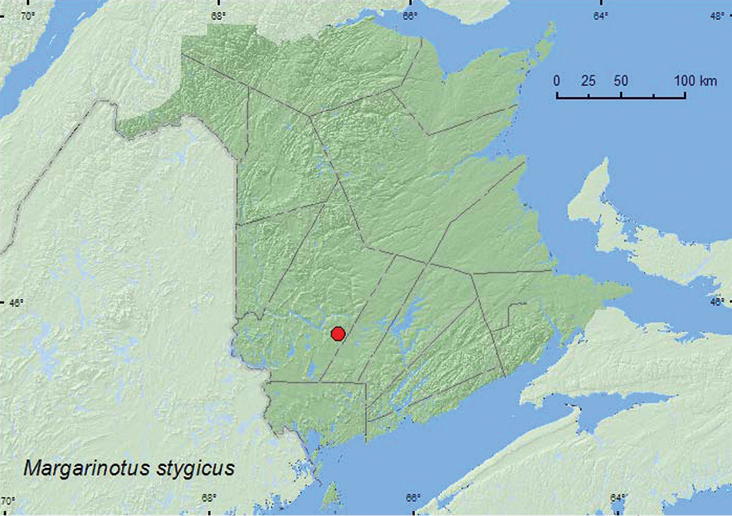






(C) 2012 Reginald P. Webster. This is an open access article distributed under the terms of the Creative Commons Attribution License 3.0 (CC-BY), which permits unrestricted use, distribution, and reproduction in any medium, provided the original author and source are credited.
For reference, use of the paginated PDF or printed version of this article is recommended.
Eighteen species of Histeridae are newly reported from New Brunswick, Canada. This brings the total number of species known from New Brunswick to 42. Seven of these species, Acritus exguus (Erichson), Euspilotus rossi (Wenzel), Hypocaccus fitchi (Marseul), Dendrophilus kiteleyi Bousquet and Laplante, Platysoma cylindricum (Paykull), Atholus sedecimstriatus (Say), and Margarinotus harrisii (Kirby) are recorded from the Maritime provinces for the first time. Collection and bionomic data are presented for these species.
Histeridae, new records, Canada, New Brunswick
The following records are based in part on specimens collected as part of a general survey by the first author to document the Coleoptera fauna of New Brunswick, a study to document the Coleoptera fauna of barred owl (Strix varia Barton) nests, and specimens obtained as by-catch in Lindgren 12-funnel traps (ConTech Inc., Delta, BC) during a study to develop a general attractant for the detection of invasive species of Cerambycidae.
Collection methodsA variety of collection methods were employed to collect the specimens reported in this study. General details are outlined in
Distribution maps, created using ArcMap and ArcGIS, are presented for each species from New Brunswick. Every species is cited with current distribution in Canada and Alaska, using abbreviations for the state, provinces, and territories. New provincial records are indicated in bold under Distribution in Canada and Alaska. The following abbreviations are used in the text:
| AK | Alaska | MB | Manitoba |
| YT | Yukon Territory | ON | Ontario |
| NT | Northwest Territories | QC | Quebec |
| NU | Nunavut | NB | New Brunswick |
| BC | British Columbia | PE | Prince Edward Island |
| AB | Alberta | NS | Nova Scotia |
| SK | Saskatchewan | NF & LB | Newfoundland and Labrador |
Acronyms of collections examined and referred to in this study are as follows:
AFC Atlantic Forestry Centre, Natural Resources Canada, Canadian Forest Service, Fredericton, New Brunswick, Canada
CNC Canadian National Collection of Insects, Arachnids and Nematodes, Ottawa, Ontario, Canada
NBM New Brunswick Museum, Saint John, New Brunswick, Canada
RWC Reginald P. Webster Collection, Charters Settlement, New Brunswick, Canada
ResultsEighteen species of Histeridae are newly reported from New Brunswick, bringing the total number of species known from the province to 42 (Table 1.). Seven species, Acritus exguus (Erichson), Euspilotus rossi (Wenzel), Hypocaccus fitchi (Marseul), Dendrophilus kiteleyi Bousquet and Laplante, Platysoma cylindricum (Paykull), Atholus sedecimstriatus (Say), and Margarinotus harrisii (Kirby) are newly recorded for the Maritime provinces of Canada.
Species of Histeridae known from New Brunswick, Canada
| Subfamily Abraeinae MacLeay |
| Tribe Plegaderinae Portevin |
| Plegaderus confusus Bousquet & Laplante |
| Plegaderus sayi Marseul |
| Tribe Acritini Wenzel |
| Acritus exiguus (Erichson)** |
| Aeletes politus (LeConte) |
| Subfamily Saprininae Blanchard |
| Baeckmanniolus dimidiatipennis (LeConte) |
| Euspilotus assimilis (Paykull) |
| Euspilotus rossi (Wenzel)** |
| Geomysaprinus moniliatus (Casey) |
| Gnathoncus barbatus Bousquet & Laplante* |
| Gnathoncus communis (Marseul)* |
| Gnathoncus rotundatus (Kugelann) |
| Hypocaccus bigener (LeConte) |
| Hypocaccus fitchi (Marseul)** |
| Hypocaccus fraternus (Say) |
| Subfamily Dendrophilinae Reitter |
| Tribe Dendrophilini Reitter |
| Dendrophilus kiteleyi Bousquet & Laplante** |
| Dendrophilus punctatus (Herbst)* |
| Tribe Paromalini Reitter |
| Carcinops pumilo (Erichson) |
| Paromalus teres LeConte |
| Subfamily Histerinae Gyllenhal |
| Tribe Platysomatini Bickhardt |
| Platysoma coarctatum J.E. LeConte |
| Platysoma cylindricum (Paykull)** |
| Platysoma deficiens (Casey)* |
| Platysoma gracile J.E. LeConte |
| Platysoma leconti Marseul* |
| Tribe Histerini Gyllenhal |
| Atholus bimaculatus (Linnaeus) |
| Atholus perplexus (J.L. LeConte)* |
| Atholus sedecimstriatus (Say)** |
| Hister abbreviatus Fabricius |
| Hister curtatus LeConte |
| Hister furtivus LeConte |
| Margarinotus brunneus (Fabricius) |
| Margarinotus cognatus (LeConte)* |
| Margarinotus confusus Wenzel* |
| Margarinotus egregius (Casey)* |
| Margarinotus faedatus (LeConte) |
| Margarinotus harrisii (Kirby)** |
| Margarinotus hudsonicus (Casey) |
| Margarinotus immunis (Erichson) |
| Margarinotus interruptus (de Beauvois) |
| Margarinotus lecontei Wenzel |
| Margarinotus merdarius (Hoffmann)* |
| Margarinotus stygicus (J.E. LeConte)* |
| Psiloscelis planipes (LeConte) |
Notes: *New to province, **New to Maritime provinces.
All records are species newly recorded for New Brunswick, Canada. Species followed by ** are newly recorded from the Maritime provinces of Canada.
The classification of the Histeridae follows
Subfamily Abraeinae MacLeay, 1819
Tribe Acritini Wenzel, 1944
New Brunswick, York Co., 15 km W of Tracy off Rt. 645, 45.6848°N, 66.8821°W, 16–30.VI.2010, R. Webster & C. MacKay, old red pine forest, Lindgren funnel trap (1, RWC).
Collection localities in New Brunswick, Canada of Acritus exiguus.
This species occurs under bark of deciduous trees (
. ON, QC, NB (
New Brunswick, Queens Co., Rees near Grand Lake, 46.0016°N, 65.9466°W, 29.V.2007, S. Makepeace & R. Webster, in barred owl nest in an artificial nest box (2, CNC, RWC).
Collection localities in New Brunswick, Canada of Euspilotus rossi.
. This species was reported from flicker (Colaptes auratus L.) nests by
ON, QC, NB (
New Brunswick, Carleton Co., Benton, 45.9961°N, 67.5864°W, 24.V.2007, Makepeace & R. Webster, in barred owl nest in natural tree cavity (1, RWC). Queens Co., Pleasant Villa, 45.7023°N, 66.1732°W, 15.VI.2007, S. Makepeace & R. Webster, in barred owl nest in natural tree cavity (4, RWC, NBM); McAlpines near Upper Hampstead Rd., 45.7250°N, 66.1200°W, 3.VI.2007, S. Makepeace & R. Webster, in barred owl nest in natural tree cavity (4, RWC, NBM); Rees, near Grand Lake, 46.0016°N, 65.9466°W, 29.V.2007, S. Makepeace & R. Webster, in nest contents of barred owl in an artificial nest box (8, NBM). Sunbury Co., Noonan, 45.9923°N, 66.4099°W, 2.VI.2007, S. Makepeace & R. Webster, in barred owl from tree hole 7 m high in red maple, damp organic material with small bones (1, NBM);Acadia Research Forest, 45.9866°N, 66.3841°W, 2–9.VI.2009, R. Webster & M.-A. Giguère, mature (100 year-old) red spruce forest with scattered red maple and balsam fir, Lindgren funnel trap (1, AFC). Westmorland Co., Sackville near Ogden Mill, 45.9216°N, 64.3893°W, 12.V.2006, S. Makepeace & R. Webster, in great horned owl nest (2, RWC, NBM). York Co., Charters Settlement, 45.8428°N, 66.7278°W, in decayed mushrooms, 16.IX.2004, R. P. Webster (1, RWC); Keswick Ridge, 46.0040°N, 66.8776°W, 23.V.2006, S. Makepeace & R. Webster, in barred owl nest in natural tree cavity (2, RWC, NBM); Pokiok Settlement (String Bog), 45.9101°N, 67.1235°W, 26.VI.2007, S. Makepeace & R. Webster, in barred owl nest in natural tree cavity (1, RWC); Marysville, 45.9750°N, 66.5700°W, 22.VI.2007, S. Makepeace & R. Webster, in barred owl nest, with dry organic material and remains of squirrel, birds, and insect parts (4, RWC, NBM).
Collection localities in New Brunswick, Canada of Gnathoncus barbatus.
Little information was previously known about the habitat and biology of this species.
BC, AB, ON, QC, NB, NS (
New Brunswick, Kings Co., near Quarries, 45.6005°N, 66.0500°W, 25.IX.2005, S. Makepeace & R. Webster, in barred owl nest in nest box on red maple, dry litter (2, RWC). Queens Co., Elm Hill, 45.7140°N, 66.1315°W, 27.VI.2007, S. Makepeace & R. Webster, in barred owl nest in tree hole in red oak, damp (urine smell) organic material with feathers, fur and small bones (2, RWC).
Collection localities in New Brunswick, Canada of Gnathoncus communis.
This species was collected from nest material from barred owl nests in natural cavities in trees or artificial nest boxes.
BC, AB, MB, ON, QC, NB, NS (
New Brunswick, Queens Co., Bayard, at Nerepis River, 45.4473°N, 66.3318°W, 24.V.2009, R. P. Webster, river margin, on sand bar in debris on sand (2, RWC).
Collection localities in New Brunswick, Canada of Hypocaccus fitchi.
A few specimens from Quebec were found on sandy beaches along rivers (
ON, QC, NB (
Tribe Dendrophilini Reitter, 1909
http://species-id.net/wiki/Dendrophilus_kiteleyi
Map 6New Brunswick, Kings Co., near Quarries, 45.6005°N, 66.0500°W, 25.IX.2005, S. Makepeace & R. Webster, in barred owl nest in nest box on red maple, dry litter (1, RWC). Queens Co., Central Hampstead, 45.6575°N, 66.1412°W, 13.VII.2006, S. Makepeace & R. Webster, hardwood ridge, in nest of barred owl in tree hole (3, RWC, NBM); Elm Hill, 45.7140°N, 66.1315°W, 27.VI.2007, S. Makepeace & R. Webster, in barred owl nest in tree hole in red oak, damp (urine smell) organic material with feathers, fur and small bones (1, RWC); Pleasant Villa, 45.7023°N, 66.1732°W, 15.VI.2007, S. Makepeace & R. Webster, in barred owl nest in natural tree cavity (1, RWC); McAlpines near Upper Hampstead Rd., 45.7250°N, 66.1200°W, 3.VI.2007, S. Makepeace & R. Webster, in barred owl nest in natural tree cavity (4, RWC, NBM); Rees near Grand Lake, 46.0016°N, 65.9466°W, 29.V.2007, S. Makepeace & R. Webster, in nest contents of barred owl in artificial nest box (1, RWC). York Co., Marysville, 45.9750°N, 66.5700°W, 22.VI.2007, S. Makepeace & R. Webster, in barred owl nest, with dry organic material and remains of squirrel, birds, and insect parts (1, RWC).
Collection localities in New Brunswick, Canada of Dendrophilus kiteleyi.
Most specimens of Dendrophilus kiteleyi were found in tree cavities in deciduous trees (
AB, MB, ON, QC, NB (
New Brunswick, Queens Co., Elm Hill, 45.7140°N, 66.1315°W, 27.VI.2007, S. Makepeace & R. Webster, in barred owl nest with chicks in a natural cavity in a red oak (1, RWC).
Collection localities in New Brunswick, Canada of Dendrophilus punctatus.
In Europe, this species was frequently found in bird nests, granaries, and mills (
MB, ON, QC, NB, NS (
Tribe Platysomatini Bickhardt, 1914
New Brunswick, York Co., Fredericton, 28.VI.1929, L. J. Simpson, in tunnel of Ips pini (in pine) (1, AFC).
Collection localities in New Brunswick, Canada of Platysoma cylindricum.
This species occurs under bark of dead pines (
ON, QC, NB (
New Brunswick, Charlotte Co., Oak Bay, 6.VII.1928, L. J. Simpson, from Ips pini tunnels (1, AFC). Sunbury Co., Acadia Research Forest, 45.9866°N, 66.3841°W, 18–24.VI.2009, 24-30.VI.2009, 18-31.VIII.2009, R. Webster & M.-A. Giguère, mature (110 year-old) red spruce forest with scattered red maple and balsam fir, Lindgren funnel traps (3, AFC, RWC). York Co., Taymouth, 29.VI.1929 (no collector given) (1, AFC); Fredericton, 22.VI.1929, L. J. Simpson, (1, AFC); 15 km W of Tracy off Rt. 645, 45.6848°N, 66.8821°W, 21-28.VI.2009, 7-14.VII.2009, 4-11.VIII.2009, 11-18.VIII.2009, R. Webster & M.-A. Giguère, old red pine forest, Lindgren funnel traps (4, AFC, RWC); same locality data but 6.VI.2009, R. Webster & M.-A. Giguère, old red pine forest, under bark scales of recently fallen red pine (4, RWC); 14 km WSW of Tracy, S of Rt. 645, 45.6741°N, 66.8661°W, 10-26.V.2010, R. Webster & C. MacKay, old mixed forest with red and white spruce, red and white pine, balsam fir, eastern white cedar, red maple, and Populus sp., Lindgren funnel traps (6, AFC).
Collection localities in New Brunswick, Canada of Platysoma deficiens.
This species is found under bark of dead pines (Pinus spp.), spruce (Picea spp.), and larches (Larix sp.) (
AB, SK, MB, ON, QC, NB, NS (
New Brunswick, Carleton Co., Meduxnekeag Valley Nature Preserve, 46.1888°N, 67.6762°W, 20.V.2005, R. P. Webster (1, RWC). Northumberland Co., 12.0 km SSE of Upper Napan near Goodfellow Brook, 46.8943°N, 65.3810°W, 23.V.2007, R. P. Webster, recent clear-cut, under bark of spruce log (1, NBM). Queens Co., Cranberry Lake P.N.A. (Protected Natural Area), 46.1125°N, 65.6075°W, 25.VI.2009, R. Webster & M.-A. Giguère, mature red oak forest, on dead red oak trunk (1, AFC); same locality data and forest type, 13–25.V.2011, 29.VI–7.VII.2011, M. Roy & V. Webster, Lindgren funnel traps (2, NBM). Restigouche Co., Jacquet River Gorge P.N.A., 47.8779°N, 66.0013°W, 13.VI.2009, R. P. Webster, mixed forest, under bark of birch with fermented sap (2, RWC). Sunbury Co., Portobello Creek N.W.A., 45.8992°N, 66.4248°W, 5.VI.2004, R. P. Webster (1, RWC); Lakeville Corner, 45.9007°N, 66.2423°W, 27.VIII.2006, R. P. Webster, silver maple swamp, among polypore fungi on poplar log (1, NBM). York Co., near Magaguadavic Lake, 45.7283°N, 67.1818°W, 24.IV.2004, D. Sabine & R. Webster (3, NBM, RWC); Charters Settlement, 45.8340°N, 66.7450°W, 14.V.2004, R. P. Webster (1, RWC); 15 km W of Tracy off Rt. 645, 45.6848°N, 66.8821°W, 4–11.VIII.2009, R. Webster & M.-A. Giguère, old red pine forest, Lindgren funnel trap (1, AFC).
Collection localities in New Brunswick, Canada of Platysoma leconti.
Platysoma leconti is found under bark of a variety of dead deciduous tree species (maples (Acer spp.), oaks (Quercus spp.), elm (Ulmus spp.), poplars (Populus sp.), ashes (Fraxinus spp.)) and pines (
NT, BC, AB, SK, MB, ON, QC, NB, NS (
New Brunswick, York Co., Charters Settlement, 45.8456°N, 66.7267°W, 10.VI.2010, R. P. Webster, beaver dam among sticks and debris on top of dam (2, RWC).
Collection localities in New Brunswick, Canada of Atholus perplexus.
Atholus perplexus has been collected from North American beaver (Castor canadensis Kuhl) lodges, muskrat (Ondatra zibethicus (L.)) nests, and in manure (
SK, MB, ON, QC, NB, PE, NS (
New Brunswick, York Co., Charters Settlement, 45.8340°N, 66.7450°W, 20.VIII.2006, R. Webster, well decayed gilled and boletus mushrooms placed in an opening of 20 year-old regenerating mixed forest (1, RWC).
Collection localities in New Brunswick, Canada of Atholus sedecimstriatus.
This species occurs in compost, dung, and carrion (
ON, QC, NB (
New Brunswick, Gloucester Co., 3 Vinot Rd. (Duguayville), 17.VI.1941, E. Dugway, 41-L68 (FIS) (1, AFC). York Co., Charters Settlement, 45.8340°N, 66.7450°W, 8.VIII.2006, 14.VIII.2006, 20.VIII.2006, R. P. Webster, baited with well-decayed gilled and boletus mushrooms (7, RWC); 15 km W of Tracy off Rt. 645, 45.6848°N, 66.8821°W, 28.VI–7.VII.2009, R. Webster & M.-A. Giguère, old red pine forest, Lindgren funnel trap (1, AFC).
Collection localities in New Brunswick, Canada of Margarinotus cognatus.
Most adults from New Brunswick were collected from well-decayed gilled and boletus mushrooms that had been placed in an opening in a 20-year-old regenerating mixed forest. One individual was caught in a Lindgren funnel trap deployed in an old red pine forest. Adults were collected during June, July, and August. Little was previously known about the biology of this species (
ON, QC, NB, NS (
New Brunswick, Carleton Co., Meduxnekeag Valley Nature Preserve, 46.1964°N, 67.6340°W, 31.V.2005, M.-A. Giguère & R. Webster, old mixed forest, in moist leaf litter at the margin of a vernal pond (1, RWC); Lower Woodstock, 46.1192°N, 67.5795°W, 7.V.2008, R. P. Webster, pasture, entrance to fox den (3, RWC). York Co., Charters Settlement, 45.8430°N, 66.7275°W, 5.V.2006, R. P. Webster, in porcupine dung at the entrance of a porcupine den (1, RWC).
Collection localities in New Brunswick, Canada of Margarinotus confusus.
This species has been collected in woodchuck (Marmota monax (L.)) burrows and carrion (
ON, QC, NB, NS (
New Brunswick, Carleton Co., Lower Woodstock, 46.1192°N, 67.5795°W, 7.V.2008, R. P. Webster, pasture, entrance to fox den (1, RWC).
Collection localities in New Brunswick, Canada of Margarinotus egregius.
This species is commonly found in woodchuck burrows early in the spring and also in various decaying organic material such as carrion, dung, and decaying mushrooms (
MB, ON, QC, NB, NS (
New Brunswick, Charlotte Co., 3.0 km NW of Pomeroy Ridge, 45.3095°N, 67.4343°W, 16.VI.2008, R. P. Webster, old growth eastern white cedar swamp, in moss and leaf litter near small vernal pool (1, RWC). Sunbury Co., Acadia Research Forest, 45.9866°N, 66.3841°W, 2-9.VI.2009, R. Webster & M.-A. Giguère, mature (110 year-old) red spruce forest with scattered red maple and balsam fir, Lindgren funnel trap (1, RWC).
Collection localities in New Brunswick, Canada of Margarinotus harrisii.
One of the New Brunswick specimens was collected in moss and leaf litter near a vernal pond, the other from a Lindgren funnel trap. In Indiana (USA), the species was usually found in cow dung and was frequent under “chunks” on the beach of Lake Michigan (
BC, AB, SK, MB, ON, QC, NB (
New Brunswick, Kings Co., ca. 2 km WSW of Browns Flat, 45.4667°N, 66.1668°W, 8.VII.2009, S. Makepeace & R. Webster, in barred owl nest box, moist organic debris and sawdust with owl pellets, small bones, feathers, with urine smell (1, RWC). Queens Co., Central Hampstead, 45.6575°N, 66.1412°W, 13.VII.2006, S. Makepeace & R. Webster, hardwood ridge, in barred owl nest in tree hole (1, RWC); Elm Hill, 45.7140°N, 66.1315°W, 27.VI.2007, S. Makepeace & R. Webster, in barred owl nest in tree hole in red oak, damp (urine smell) organic material with feathers, fur and small bones (1, RWC); Cumberland Bay, 46.0000°N, 65.9333°W, 28.VI.2009, Makepeace & R. Webster, in barred owl nest, moist leaves and debris with owl pellets, small bones, with urine smell (1, RWC); ca. 1.5 km NW of McAlpines, 45.7333°N, 66.1333°W, 8.VII.2009, S. Makepeace & R. Webster, in barred owl nest box, moist organic debris and sawdust with owl pellets, small bones, feathers, with urine smell (2, RWC). York Co., Marysville, 45.9750°N, 66.5700°W, 22.VI.2007, S. Makepeace & R. Webster, nest box contents of barred owl, with dry organic material and remains of squirrel, birds, and insect parts (1, NBM).
Collection localities in New Brunswick, Canada of Margarinotus merdarius.
In Europe, this species occurs in dung, fungi, compost, and decaying vegetables and in bird nests and henhouses (
BC, AB, MB, ON, QC, NB, NS (
New Brunswick, York Co., Charters Settlement, 45.8395°N, 66.7391°W, 19.VI.2004, R. P. Webster, pitfall trap baited with dog dung (1, RWC).
Collection localities in New Brunswick, Canada of Margarinotus stygicus.
Relatively little is known about the habitat requirements of this species. The scant habitat data available suggest that the species is probably associated with mammal nests. Adults have been collected by sifting around a deserted mouse nest (
MB, ON, NB, NS (
We thank Caroline Simpson for editing this manuscript. Yves Bousquet (Agriculture and Agri-Food Canada (CNC), Ottawa) is thanked for determining the specimens and revising the manuscript and anonymous reviewer is thanked for useful comments. We thank Nichole Brawn, Katie Burgess, Marie-Andrée Giguère, Nancy Harn, Cory Hughes, Ervin Kovacs, Colin MacKay, Wayne MacKay, Jessica Price, Michelle Roy, and Vincent Webster for technical assistance and collecting specimens. We thank Natural Resources Canada Canadian Forest Service; the Canadian Food Inspection Agency; and USDA APHIS for funding the Lindgren funnel trapping component of this study. We thank the Canadian Wildlife Service for funding insect surveys at the Portobello Creek National Wildlife Area, and the New Brunswick Environmental Trust Fund and New Brunswick Wildlife Trust Fund for funding various insect surveys over the past 7 years. The Meduxnekeag River Association is thanked for permission to sample beetles at the Meduxnekeag Valley Nature Preserve (which includes the Bell Forest). The New Brunswick Department of Natural Resources (Fish and Wildlife Branch) is thanked for issuing permits for sampling in the Protected Natural Areas and logistical support. Survey work in the Jacquet River Gorge Protected Natural Area was organized through the New Brunswick Museum with external funding from the New Brunswick Environmental Trust Fund, Salamander Foundation, and the New Brunswick Wildlife Trust Fund.
